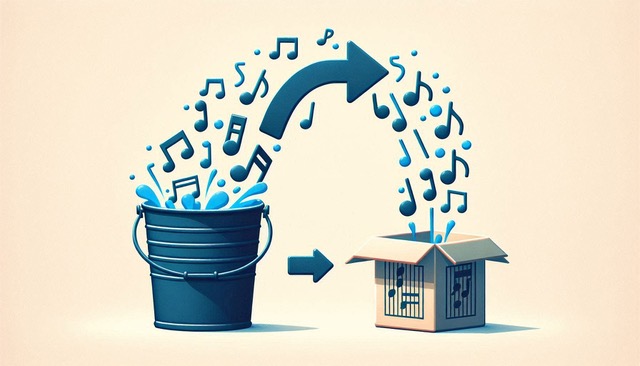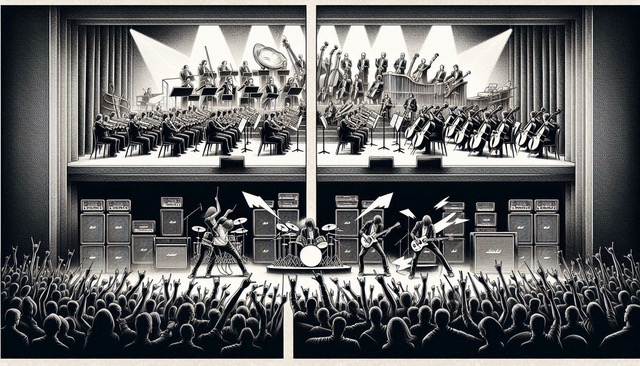Editorâs note: Besides following tech developments, our author is a musical composer (Juilliard-trained). He has provided a musical composition for you to listen to while reading this column. This piece is called âRise Prelude Piano Version.â
Amplification has revolutionized music. In the past, if you wanted to deliver music to a larger audience, you had to add more instrumentsâthis is how the orchestra grew to 100 members. Now that we have amplification, even a three-piece rock band can be louder than a symphony orchestra. Even Tanglewood uses sound reinforcement so people on the lawn can hear the orchestra better. There are many ways in which amplification impacts music style. The guitar was relatively unimportant until it evolved into the electric guitar, which had a tremendous impact on musical styles, enabling rhythm and blues, rock and roll, punk rock, and more.
The electric guitar bumped off the saxophone, which dominated popular music, along with the trumpet and clarinet, which were the main melody instruments. These acoustic instruments were so loud that they did not require amplification to be heard, enabling the significant band era. It costs a lot less to hire a rock band than an orchestra or a big 16-piece jazz band. This has resulted in big bands going out of business as they were no longer economically feasible. Acoustic guitars also became amplified, permitting the singer-songwriter genre to explode and probably wiping out the accordion as a prevalent accompaniment instrument.
In 1951, Leo Fender invented the electric bass, making rock music danceable and transforming traditional jazz into contemporary jazz. In addition to supplying low-frequency support, the electric bass became a melody instrument capable of taking solos like a sax, trumpet, or clarinet. Not every band has a piano, and not every band has a guitar, but every band, no matter what its musical style, does have a bass guitar. It is hard to overestimate the importance of this instrument. By the way, it was always much easier to get a gig as a bass player; they were in greater demand than guitarists or piano players.
Several significant improvements continue to impact modern amplification. Many small battery-powered, self-contained loudspeaker amplification systems are now available, and the majority of them are also Bluetooth wireless. These are used by every type of music, from world-beat music to singer-songwriters, because they are so convenient, flexible, and easy to set up.
The ability to easily record and deliver music has made it ubiquitous. We now have hot and cold running music on demand everywhere, from our cars to the woods.
We now have hot and cold running music. Howard Lieberman created this image using DALL-E-2, an AI software program.
The ways we store music impact song length and styles of music. 78 rpm records could only store three minutes of music, which had a tremendous impact on the duration of pieces of music. As the medium changed to 33 rpm stereo disks, reel-to-reel tape recorders, eight tracks, cassettes, iPods, iPhones, and now streaming, the availability of music has radically changed, and the styles of music that came about have changed enormously. For example, young people no longer listen to albums, only to singles. The notion of a theme album like the Moody Blues or the rock opera âTommyâ from the Who is now considered obsolete, but people can hear music anywhere at any time. This has permitted world music to become globally available instead of only in local indigenous regions.
Streaming is the dominant way to deliver music these days, but it is not optimized for classical music, which is generally of longer duration and requires more bits per second to capture adequately due to its large dynamic range from soft to loud. Additionally, streaming music is almost always very compressed, which is another way to detract from the quality of sound delivery systems for classical music. Technology is also altering and reducing audience attention spans.
Musicians who used to spend a couple of thousand dollars a day in a professional recording studio can now buy a laptop with a recording interface for the same price and have an infinite amount of time to experiment with recording themselves. Many recording studios, even big famous ones, are now going out of business.
 Signal processing, which enhances and amplifies sound, can transform music in many ways. Howard Lieberman created this image with the assistance of DALL-E-2, an AI software program. Howard Lieberman created this image with the assistance of DALL-E-2, an AI software program.
Signal processing, which enhances and amplifies sound, can transform music in many ways. Howard Lieberman created this image with the assistance of DALL-E-2, an AI software program. Howard Lieberman created this image with the assistance of DALL-E-2, an AI software program.
Out-of-tune singers and out-of-time drummers are now routinely corrected by auto-tuning and quantizing. This has resulted in the great democratization of people who cannot play well but are famous. We can now change the tonal quality of music, both live and recorded, as well as many other musical variables. Computers have become so fast that processing, which used to be very laborious or even impossible, is now routine. Processing can and often permits low-quality (low-cost) instruments and low-quality performers to deliver credible performances.
These are only some examples. The overall effect of technology has been the crossing of musical boundaries and the busting of genre silos. Defining jazzâcontemporary jazz, traditional jazz, jazz, jazz-rock fusion, rapâis currently challenging. Technological developments facilitated all of these. For example, the bass guitar is under 75 years old, and the synthesizer is under 50. These have both rippled through musical styles in very many ways.





